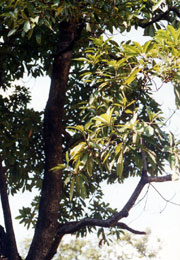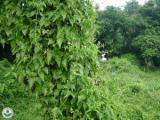|
Place: Computer Classroom
Time: 01/25/94
Teacher
asked us to find a native plant of Taiwan. What I found is
large-leaved Nanmu.
Scientific name: Machilus japonica sieb.
& zucc. var. kusanoi (Hayata) Liao
Another name; Machilus kusano,
large-leaved Nanmu
Characteristics: an evergreen tree, with
large coriaceous leaves, has light red bract when germinates in the spring,
new leaves in light purple-green color, old leaves in dark green, highrise.
New leaves will form a red leaf landscape when spring comes. Rich glutinous
liquid in the bark can be used as joss stick material. The perianth of
innamomum family is slender and small. There is no difference between calyx
and petal. The large-leaved Nanmu also has such characteristics. The fruit is
a kind of spherical nut, in purple-black color when it gets mature, with damp
and heat resistant nature. When the fruits get mature, it demonstrates that
the forest where it stands enters successive mature stage. From July to
November every year, the fruits are the favorite food of the squirrels.
Distribution;
in the gullies and damp areas of broad-leaved forest on Taiwan Island,
with a medium or low elevations. It is one of the important species of broad-leaved
forest in Taiwan.
Areas with low elevation > phytocoenosis in the areas with low
elevation > large-leaved Nanmu

|
|
On Taiwan
island, there are numerous plants. Some are native species, such as Taiwan
goldenrain tree, Botel Tobago persimmon, Botel Tobago Cinnamon Tree, etc..
Some are exotic species (it means a species that is not native to this area).
Some of the exotic plants will cause some other plants to grow, such as
Mikania micrantha Kunth, Eichhornia crassipes Solms-Laub and so on.
In recent years, due to a great number of imported exotic plants, the
native plants have decreased year after year. Mikania micrantha Kunth is such
an example. The original intention of the government was to import some
Mikania micrantha Kunth for better soil and water conservation. Unexpectedly,
the “Mikania micrantha Kunth” has a great impact on our native plants. They
grow too fast, scramble on the trees and cover them, which leads to the death
of the trees as they lack sufficient light and air. It does great harm to
both our economics and ecology. Except “Mikania micrantha Kunth”, another aquatic
plant Eichhornia crassipes Solms-Laub also harms native plants. It floats on
the water surface, and prevents air from entering the water, which leads to
the death of fishes, shrimps and plants therein. How terrible! Whereas, the
Eichhornia crassipes Solms-Laub cannot live without water. It does less harm
than “Mikania micrantha Kunth”. However, it still endangers some native
plants!
The
following is the information of Mikania micrantha Kunth
Chinese name: Xiaohuamanzelan (green cancer)
English name: Mikania micrantha Kunth
Family; compositae,
climbing plant
Flowering period:
October to next February
Dispersal way of seeds: wind or activities of
animals, insects and humankind
Characteristics; long and slim stem, crawling
or climbing, branchy, root can be generated from any section
The following picture shows the harm of Mikania micrantha Kunth

|